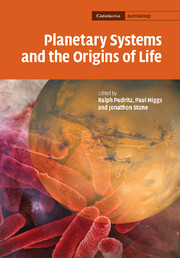Book contents
- Frontmatter
- Contents
- List of contributors
- Preface
- Part I Planetary systems and the origins of life
- Part II Life on Earth
- 6 Extremophiles: defining the envelope for the search for life in the universe
- 7 Hyperthermophilic life on Earth – and on Mars?
- 8 Phylogenomics: how far back in the past can we go?
- 9 Horizontal gene transfer, gene histories, and the root of the tree of life
- 10 Evolutionary innovation versus ecological incumbency
- 11 Gradual origin for the metazoans
- Part III Life in the Solar System?
- Index
7 - Hyperthermophilic life on Earth – and on Mars?
Published online by Cambridge University Press: 13 August 2009
- Frontmatter
- Contents
- List of contributors
- Preface
- Part I Planetary systems and the origins of life
- Part II Life on Earth
- 6 Extremophiles: defining the envelope for the search for life in the universe
- 7 Hyperthermophilic life on Earth – and on Mars?
- 8 Phylogenomics: how far back in the past can we go?
- 9 Horizontal gene transfer, gene histories, and the root of the tree of life
- 10 Evolutionary innovation versus ecological incumbency
- 11 Gradual origin for the metazoans
- Part III Life in the Solar System?
- Index
Summary
Introduction
Every living organism is adapted to a specific growth temperature. In the case of humans, this is 37 °C and an increase by 5 °C becomes fatal. In the world of microbes, the growth temperature range is much more diverse: heat lovers (‘thermophiles’) grow optimally (fastest) at temperatures up to 65 °C (Brock, 1978; Castenholz, 1979). Since the time of Pasteur, it had been assumed generally that growing (vegetative) cells of bacteria were killed quickly by temperatures of 80 °C and above. The Pasteurization technology is based on this observation. In contrast, during the past few decades, hyperthermophiles (HT; Stetter, 1992) that exhibit unprecedented optimal growth temperatures in excess of 80 °C have been isolated (Stetter et al., 1981; Zillig et al., 1981; Stetter, 1982). HT turned out to be very common in hot terrestrial and submarine environments. In comparing the growth requirements of these present-day HT with the conditions on ancient Earth, similar organisms could or even should have existed already by Early Archaean times. Propelled by impact energy, microbes could have spread in between the planets and moons of the early Solar System. Is there any evidence for the existence of microbes at that time? Most likely, yes. But the recognition of ancient microfossils on the basis of morphology turned out to be difficult, leading to controversy. Nevertheless, there are chemical traces of life within rocks from Precambrian deep sea vents (Schopf et al., 1987; Brasier et al., 2002; van Zullen et al., 2002).
- Type
- Chapter
- Information
- Planetary Systems and the Origins of Life , pp. 135 - 148Publisher: Cambridge University PressPrint publication year: 2007



